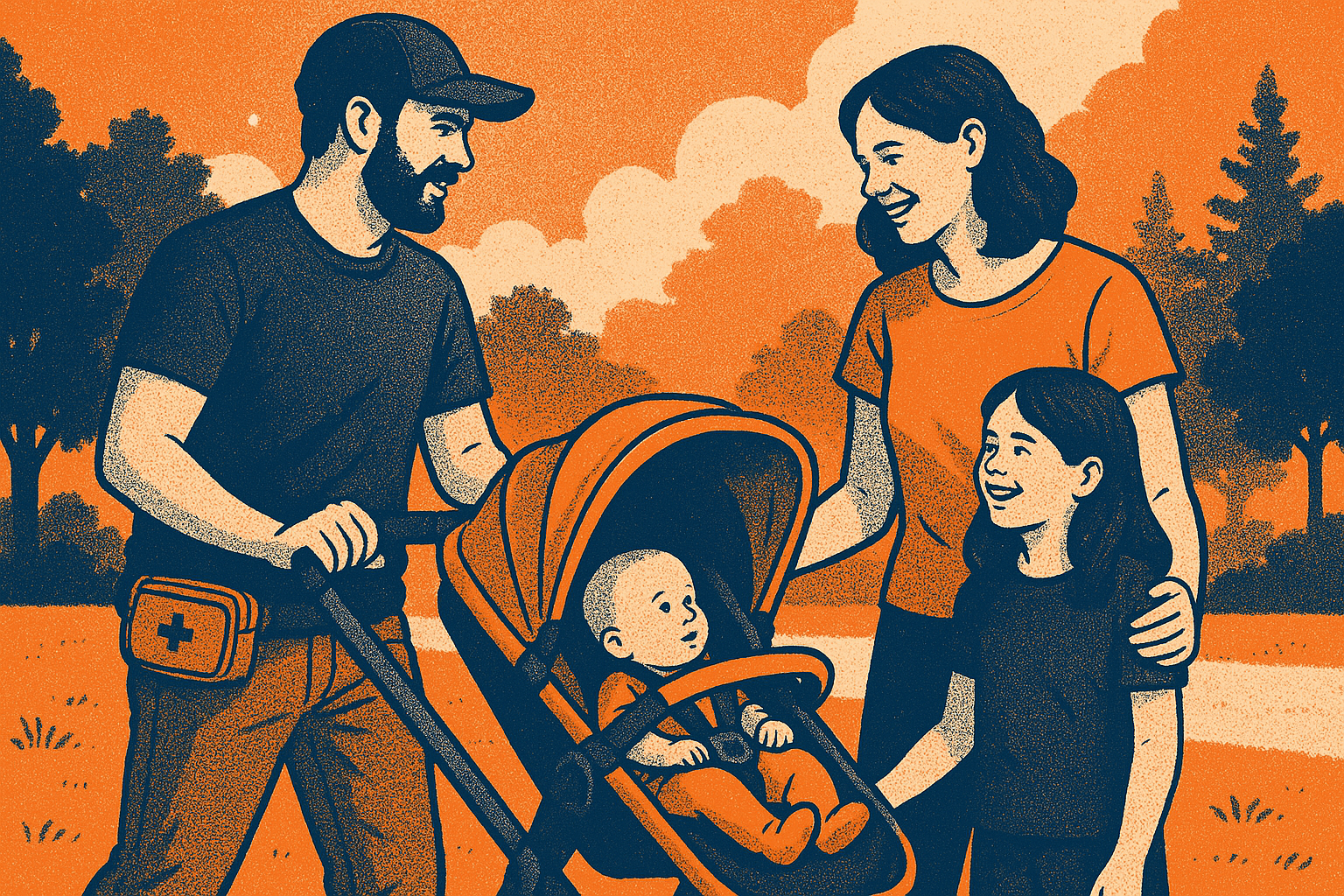Dad’s Everyday Carry: A Practical Family Guide
Written by: Bill Raymond

Dad’s Everyday Carry: A Practical Family Guide
You don’t need a trunk full of gear to be the calm parent who always has what’s needed. This guide keeps it minimal, safe, and family-first.
Want a shortcut? Get the one-page Dad EDC checklist (download).
What is Dad EDC? Core principles
Dad EDC is a small set of items you carry every day to solve common family problems fast: minor cuts, messy hands, loose screws, dark parking lots, and small comfort needs. It’s not tactical gear. It’s practical, kid-centered peace of mind.
Three principles keep it simple:
- Accessibility: If you can’t reach it in seconds while holding a child’s hand, it’s not everyday carry.
- Safety for kids: Choose items with safe caps, locks, and storage. Keep hazards secured and out of reach.
- Multipurpose value: Each item should solve more than one common problem.
Pick one small carry system you’ll actually use: pockets only, a slim pouch in your bag, or a stroller organizer. Consistency beats complexity.
Next action: Choose your carry style (pocket, pouch, or stroller organizer) and commit to it today.
Pocket & bag basics: minimal EDC for quick family outings
Keep the on-body kit tiny and focused on fast fixes. Bandages and wipes handle most scrapes. A small flashlight helps in dark restrooms, under seats, or at night. A compact multi-tool (where legal) solves loose screws, packaging, and quick snips. Hand sanitizer covers the rest.
Pockets are fastest but can get scattered. A palm-size zip pouch keeps everything together and moves between outfits, diaper bags, and strollers. Either way, keep hazardous items zipped away from curious hands.
Place quick-help items where you can reach them with one hand: front pocket for a tiny flashlight, coin pocket for sanitizer, outer bag pocket for bandages. Keep sharp tools, meds, and pressurized items in zipped internal pockets out of children’s reach.
Next action: Build a palm-size kit and stage it in the same spot every day.
Minimal pocket kit checklist (one-liner items)
Use this as a starter list. Add or remove items based on your family’s needs.
- Adhesive bandages (varied sizes) + a few antiseptic wipes — for minor cuts and scrapes (AAP/HealthyChildren and Red Cross align on these basics).
- Small roll of gauze or a few sterile pads — for slightly bigger scrapes.
- Tweezers — splinters and stingers.
- Single-use cold pack (mini) — bumps and bruises.
- Compact flashlight (single-button) — dark parking lots, bathrooms, power flickers.
- Hand sanitizer (travel size) — before snacks, after playgrounds.
- Compact multi-tool or small scissors (where legal) — packaging, loose screws, quick fixes; secure and locked away from kids (see manufacturer guidance).
- A couple of tissues or a folded dog-waste bag — cleanup, phone-in-the-rain cover, impromptu trash bag.
- Phone with emergency contacts saved, including Poison Help.
Bag vs pockets: organizing for speed and child-safety
- Put sharp tools and meds in an internal, zipped pocket. Out of sight, out of reach.
- Mark a “quick grab” outer pocket with bandages and wipes so you don’t expose the whole kit to kids.
- In a stroller organizer, keep only nonhazardous items on top (wipes, tissues, snack bag). Zip hazards in the under-seat basket.
Kid-by-kid: EDC items for infants, toddlers, and school-age kids
Your kit shifts as kids grow. Keep the core the same and swap a few items by age.
Infants: Focus on comfort and clean. Pack diapers, wipes, a compact changing pad, a small blanket or muslin, a backup pacifier with cover, and a spare onesie in a zip bag. Add a burp cloth and disposable diaper bags for odors.
Toddlers: Expect mess and motion. Add a snack cup, sippy or water bottle, travel-size sunscreen, a small hat, and a spare outfit. Keep kid-friendly bandages ready; tweezers help with splinters.
School-age: Add personal wipes, a small comfort item (fidget or mini book), basic wound-care supplies, and a family meeting point plan for busy places. Teach basic first-aid awareness: show them where bandages are and how to ask for help.
Next action: Review your bag and swap in 3–5 age-appropriate items for your oldest child’s stage.
Infant-focused tips (safety & meds)
Keep infant medications in original packaging with dosing tools and labels. Store them in a zipped pocket away from little hands. Sanitize feeding gear and follow safe storage guidance for formula or breast milk. If you suspect an exposure or ingestion, call Poison Help and contact your pediatrician for non-emergency advice.
Toddlers & older kids: what changes
As kids get mobile, small-wound care and splinter removal become common. Keep tweezers, kid-friendly bandages, and antiseptic wipes handy. Childproof your carry: blades locked, meds secured, and no loose pills. A snack and a small distraction toy can prevent risky wandering or tantrums.
Car, stroller, and travel: packing for road trips and flights
Your vehicle is an expanded kit. NHTSA and AAA recommend a dedicated car emergency kit with first-aid items, a flashlight, blankets, water, and basic tools. Keep a cabin “grab bag” for fast access and bulk supplies in the trunk. For strollers, pack light to avoid tipping: wipes, tissues, snacks, a small water bottle, hat, and a compact rain cover. Check stroller weight limits and confirm no recalls (CPSC).
Flying adds rules. Know the TSA 3-1-1 liquids rule (3.4 oz/100 mL containers in a 1-quart bag). Medically necessary liquids and some baby items can be excepted when declared — keep meds in original containers with labels. For young kids, plan to gate-check strollers and many car seats; check FAA guidance on approved child restraints.
Next action: Stage a small “cabin grab bag” in your car today and review stroller weight limits before your next outing.
TSA & flying with kids: quick rules parents need
- 3-1-1 rule for most liquids; declare medically necessary liquids and children’s items that qualify for exceptions. Keep prescriptions and labels visible.
- Pack a change of clothes for the child and a light spare shirt for you in a compression bag.
- Gate-check strollers and many car seats; check airline policies and FAA guidance before you fly.
Car kit checklist & storage tips for families
Cabin “grab bag” (glove box or door pocket):
- Adhesive bandages, antiseptic wipes, small gauze pads
- Compact flashlight/headlamp, spare batteries
- Hand sanitizer, tissues, a few disposable bags
- Phone charging cable and power bank
Trunk kit (NHTSA/AAA style):
- Larger first-aid kit (gauze roll, elastic bandage, triangular bandage)
- Reflective triangle/vest, basic tool kit, duct tape
- Jumper cables or jump starter, tire inflator or sealant
- Blanket, spare water bottles (rotate stock), weather-appropriate extras
- Paper towel roll, baby wipes, spare kid clothes in zip bags
- Car-seat manual or a quick-check card for installation reminders
Store the grab bag in the cabin for speed and the heavier kit in the trunk to reduce theft risk and clutter.
Compact first-aid: pocket kits, car kits, and when to seek help
First aid for families is about simple supplies and calm steps. AAP/HealthyChildren and the Red Cross agree on the basics: adhesive bandages, antiseptic wipes, sterile gauze, and tweezers. In your pocket kit, carry a few of each plus a mini cold pack. In the car kit, add an elastic wrap, larger sterile pads, and disposable gloves.
How to use it (high level): clean the area, apply pressure for bleeding, cover with a bandage, and monitor. Replace used items the same day so your kit stays ready. Keep meds age-appropriate and follow labels; when unsure, ask your healthcare provider.
Know your limits. Red Cross and Mayo Clinic guidance stress recognizing red flags early. Heavy bleeding that won’t stop with pressure, trouble breathing, a head injury with confusion or vomiting, a deep or dirty wound, severe burns, or any suspected poisoning are reasons to call emergency services or Poison Help right away.
Save Poison Help in your phone and keep the contact on your fridge. They can guide you in real time for exposures and ingestions while you wait for help.
Next action: Build a pocket first-aid card: “clean, pressure, cover, call if red flags” and stash it with your kit.
Quick red flags & when to call for help
Call emergency services for: trouble breathing, unresponsiveness, severe bleeding, major burns, or signs of a serious head injury (worsening headache, repeated vomiting, confusion). For exposures or ingestions, call Poison Help immediately. When in doubt, seek professional care — fast action beats guesswork.
Tools, legality, safety & maintenance
Family-friendly tools pay off when they are simple and safe. A compact multi-tool with locking blades and covered tools can handle loose screws, packaging, and quick fixes. A small pair of safety scissors is a good blade-free alternative for many settings. A single-button flashlight is useful whenever you’re in the dark.
Legal and safety notes: Check local laws before carrying knives, pepper spray, or restricted tools. TSA prohibits many sharp tools in carry-on bags; pack them in checked luggage or leave them at home when flying. Follow manufacturer guidance for locking and storing tools. Always keep hazardous items zipped away from children.
Budget picks & buying criteria: Prioritize durability, one-hand use, and safety features (locking tools, covered blades, child-resistant caps). Choose compact sizes that fit your actual carry spots. Prefer reputable brands with clear manuals and spare-part support. Avoid novelty gadgets that add bulk without solving real problems.
Maintenance matters. Do a quick monthly check for missing items, dead batteries, and dried-out sanitizer. Do a quarterly deep check on car kits and meds for expiration. After any use, restock the same day so you don’t get caught short next time.
Want help staying on track? Subscribe for weekly family-preparedness tips, and grab the one-page Dad EDC checklist (download).
Next action: Put a 10-minute “EDC check” on your calendar for the first weekend of every month.
Replenishment routine: simple schedule and checklist
- Monthly: Quick visual check of your pocket kit, flashlight test, battery check, sanitizer top-off.
- Quarterly: Restock the car kit, replace expired items, rotate bottled water, and update any child documents or allergy notes.
- After any use: Replace items the same day and do a 60-second audit of what else is low.
Notes & disclaimers
- This guide is informational and not medical advice. For medical emergencies, call local emergency services immediately.
- Check medication labels and consult a healthcare provider before giving any medicine to children.
- Check local laws for carrying knives, pepper spray, and other tools; this guide does not provide legal advice.
- Always verify product safety and recalls with the Consumer Product Safety Commission (CPSC) before using child gear.
- For poison emergencies or questions, use Poison Help for immediate guidance.
- For first-aid basics and kit contents, see guidance from AAP/HealthyChildren and the American Red Cross. For car safety and kits, see NHTSA and AAA. For travel rules, see TSA and FAA. For emergency symptoms, see high-level guidance from the Mayo Clinic.
Save a printable car-kit checklist to keep in your glove box.
Next action: Save this article, add Poison Help and your pediatrician to favorites, and print the car-kit checklist today.
Ready to Transform your Business with Little Effort Using Vertical?
Bill Raymond
Bill is the voice behind Prepper Dad. A near 20-year National Guard veteran who has planned and executed domestic-response missions from hurricanes to cyber outages. Bill blends boots-on-the-ground experience with geospatial intelligence know-how to coach busy families toward calm, commonsense preparedness. When he’s not fine-tuning go-bags, he’s chasing adventures with his wife and kids around New England.

